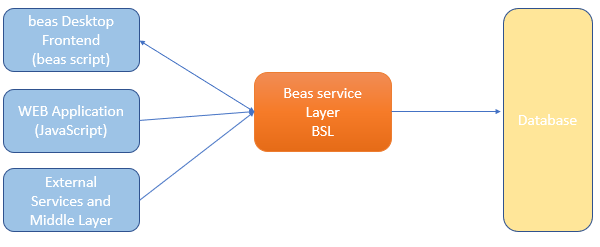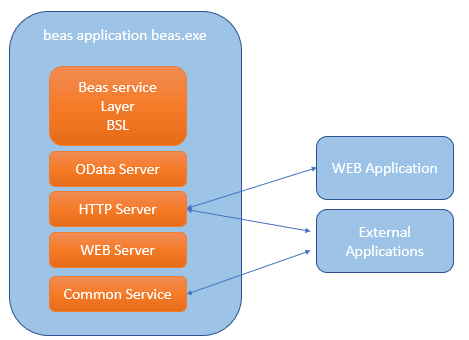Beas Service Layer
The ![]() Beas Service Layer is a middle layer between the application, frontend, or another backend and the database. It is a new generation extension API for consuming Beas and SAP Business One data and services.
Beas Service Layer is a middle layer between the application, frontend, or another backend and the database. It is a new generation extension API for consuming Beas and SAP Business One data and services.
BSL uses ODATA syntax.

With BSL you can create WEB Applications and services without developing a backend. BSL is working the same way as the SAP Service Layer.
It is possible to use BSL via the common service and HTTP.
The components in the Beas core are:
| • | OData Server |
| • | WEB Server |
| • | HTTP Server |
Additional components or services are not required.

Questions and answers
|
Not all Objects available currently, but the functionality is extended to more objects in each new version. |
BSL is compatible with both MSSQL and HANA databases. It generates database optimized SQL statements. |
Beas does not use any additional tools. All required middle layers are completely integrated and no additional interfaces are required. This results in a very fast solution |
If you use BSL via HTTP, then there might be security concerns, but in a normal use case this solution only needs to be used internally. If you need access to BSL externally, you must use a HTTPS proxy server.
If user made a login in the WEB Server (example web application), the user have from the current browser session full access to the complete functionality of the BSL. Current it's not possible to define any access rules. |
BSL uses ODATA. The data is transferred using JSON. ODATA 2, ODATA 3 and ODATA 4 are partially supported. Additional functions are supported, that are not ODATA standard. The interface is optimized for the requirements of BEAS and SAP.
BSL supports additional formats for the returned data, for example:
|
SAP UDF'S supported in most of transaction documents. |
Currently Beas BSL is not compatible with these products. See the activity log for details. |
